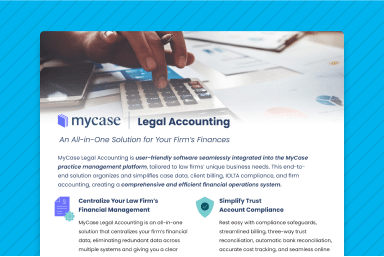Reopening Your Law Firm Part 4: Employment Law Issues
As most states shift into phased reopening plans, you’re undoubtedly thinking about the process of opening your law firm’s doors. As I’ve discussed in my last few posts, reopening a law firm in the midst of a worldwide pandemic is no easy feat – and it’s an issue of first impression for all of us. There are lots of unfamiliar issues to think about and as a result, you may not know where to start.
That’s why I’ve written this 4-part series of blog posts that cover all of the issues that will need to be addressed prior to reopening your law firm. In Part 1 I discussed the importance of creating a reopening committee, in Part 2 I focused on how to prepare your workplace, and in Part 3 I discussed how to prepare your workforce. In today’s post I’ll cover another important topic: the employment law issues you’ll need to familiarize yourself with so that your firm will be fully prepared should an employee become ill or need time off to care for a loved one who is unwell.
There are a number of new federal and state employment laws that were established due to the pandemic that are designed to protect employees who are affected by COVID-19 in one way or another. In this post I’ll be discussing the relevant federal laws that were newly enacted, but please be aware that your state likely passed comparable laws that interact with the federal laws, so it’s important for you to make sure to brush up on those, too.
In this post I’ll be relying in part on the information provided in this Legal Intelligencer article, so take the time to read it in its entirety. Below, I’ll summarize the key information you need to know about the new federal laws. Note that this information is accurate as of early June, but is subject to change based on subsequent amendments, etc.
COVID-19 federal employment law issues
There are two newly enacted pieces of federal legislation to to be aware of that will affect your employees as they return to work. The Families First Act was enacted in March and established two forms of paid leave related to the COVID-19 crisis: 1) a two-week paid leave (emergency leave), and 2) the expansion of the Family and Medical Leave Act (FMLA) to provide additional paid leave (expanded FMLA leave).
Emergency leave
First, let’s take a look at the paid emergency leave. This legislation was enacted to provide employees directly affected by COVID-19 with emergency leave. It applies to the timeframe beginning on April 2, 2020 and runs through December 31, 2020, and applies to employers with fewer than 500 employees.
This legislation provides full-time employees with two weeks of paid sick leave (and part-time employees with the equivalent of their average hours per week for two weeks) as long as the employees are unable to work or telework for one of the following reasons:
- They are subject to a quarantine or isolation order;
- A health care provider advised them to self-quarantine;
- They are experiencing symptoms and seeking a medical diagnosis;
- They are caring for an individual (not limited to family members) who is subject to a quarantine order, has been advised to self-quarantine or is experiencing symptoms;
- They are caring for a son or daughter whose school or place of care has been closed or the childcare provider is unavailable; or
- They are experiencing similar conditions to any specified by the Secretary of Health and Human Services in consultation with the Secretaries of Labor and the Treasury.
The amount of sick leave will vary depending on the reason for the sick leave. For the first 3 categories set forth above, employees are entitled to their regular rate of pay capped at $511 per day. For the last 3 categories, employees are entitled to receive two thirds their regular rate of pay capped at $200 per day.
The emergency leave of two weeks of paid sick time is provided in addition to whatever paid sick leave was already available to the employee prior to the law being enacted. Note that the employer may not require other accrued paid time off to be used prior to the employee taking advantage of the mandated paid sick leave under the Families First Act.
Expanded FMLA leave
The Families First Act also expands the protections of the FMLA to provide up to 12 weeks of leave, which includes 10 weeks of paid leave for eligible employees at two thirds their regular rate of pay. Note that just as is the case with emergency leave, this requirement is applicable only to employers with fewer than 500 employees.
To be eligible for leave, employees must have been on the employer’s payroll for at least 30 days, and it only applies when employees are unable to work or telework due to a need to care for one or more of their children as a result the closing of their child’s school or child care has been closed due to the COVID-19 crisis. Eligible employees will receive two weeks of unpaid leave and 10 weeks of paid leave.
Finally, these two pieces of legislation – the emergency leave and the expanded FMLA leave – run concurrently, so even though the first 2 weeks of leave under the expanded FMLA are unpaid, employees will nevertheless receive pay for the first 10 workdays pursuant to the paid emergency leave established by the legislation.
Exemptions for small employers
Last but not least, small employers with less than 50 employees are exempted from the requirements of the Families First Act, as long as they meet the following requirements:.
- The leave requested would result in the small business’s expenses and financial obligations exceeding available business revenues and cause the small business to cease operating at a minimal capacity;
- The absence of the employee would cause substantial risk to the financial health or operational capabilities of the business because of the employee’s specialized skills, knowledge of the business, or responsibilities; or
- There are not sufficient workers to perform the labor or services provided by the employee, and these labor or services are needed for the small business to operate at a minimal capacity.
You can learn more about both types of leave at the Department of Labor website here.
Finally, find out how other law firms are approaching reopening their law firms in a FREE webinar later this week, “Reopening – What Law Firms Need To Know.” Learn more and sign up here.


